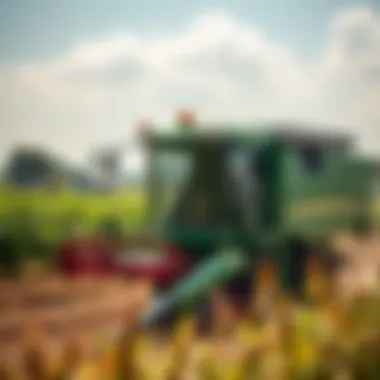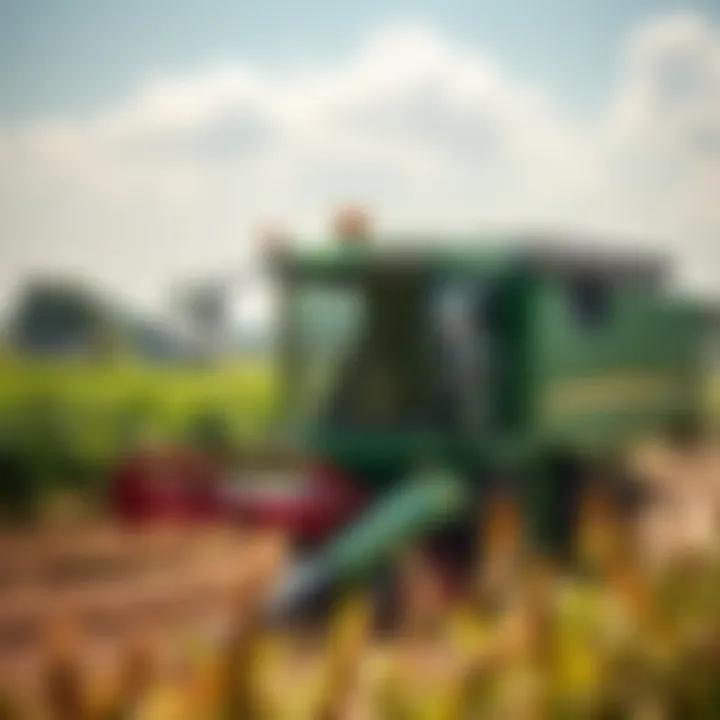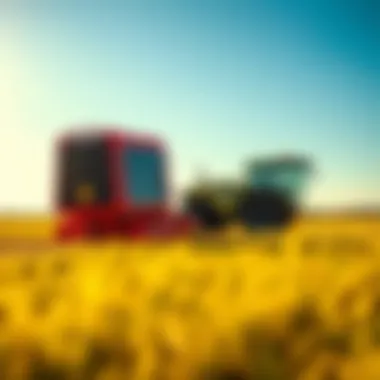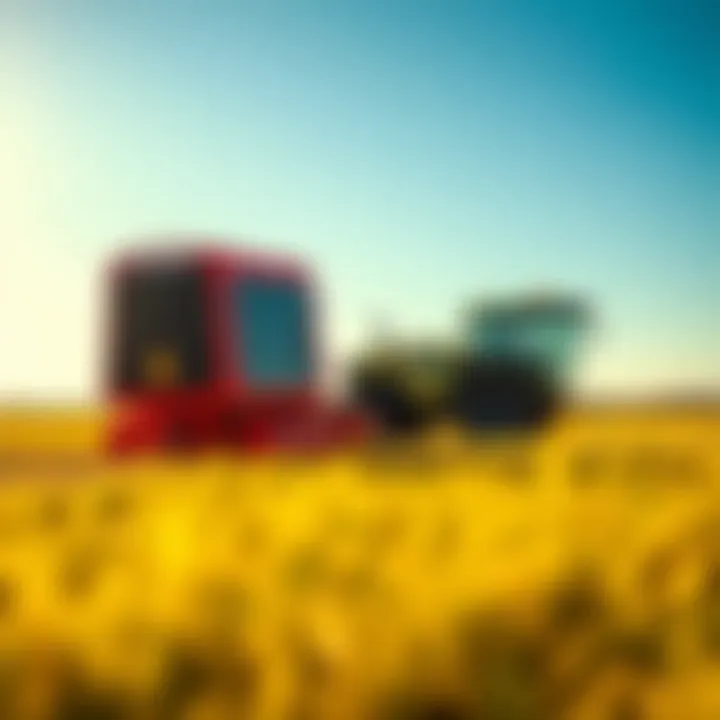Understanding the Chopper Box: A Complete Overview


Intro
The chopper box has quietly become a cornerstone in contemporary agriculture, bridging the gap between traditional practices and modern efficiency. For farmers across different regions, be it a sprawling field of wheat or a small backyard garden, understanding the mechanics of this tool is akin to gleaning insights into the future of farming. It’s not just a piece of equipment; it’s a point of transformation in how crops are processed, promoting not only higher yields but also better quality produce.
At its core, the chopper box maximizes potential—whether that be in the field or in the shed. With the growing challenges posed by climate change, labor shortages, and a burgeoning global population, the importance of such tools is more profound than ever. This article aims to peel back the layers of the chopper box, examining its features, benefits, and practical applications, while also showcasing real-world examples to solidify understanding.
Topic Overview
Definition and Importance
So, what exactly is a chopper box? In simple terms, it’s a mechanical device designed to cut and shred crop materials into smaller, manageable pieces. Think of it as the Swiss Army knife for agricultural processing, versatile in handling different types of crops, from straws to stems. Farmers use it not just for efficiency, but also to improve the overall quality of harvested products.
The significance of the chopper box lies in its ability to streamline post-harvest processes. With cutting-edge designs, this tool allows farmers to preserve nutrients while minimizing waste, catering to both economic and environmental sustainability goals. Integrating this tool into farming practices can mean the difference between a lackluster yield and a bumper harvest.
Brief History and Evolution
The chopper box didn't materialize overnight. Tracing its roots back to the earlier days of mechanized agriculture, it has undergone significant transformation in design and functionality. Originally, farmers relied on manual labor to chop crops, a labor-intensive process that was not only time-consuming but also often inefficacious. With the advent of machinery during the industrial revolution, several iterations emerged, each building upon the lessons learned from the previous model.
In recent decades, technological advancements have catalyzed the evolution of chopper boxes, introducing features like adjustable cutting speeds, enhanced safety mechanisms, and even the ability to interface with smart farming technologies. Such enhancements have opened the doors to innovative agricultural solutions, affirming the chopper box’s place in today’s agricultural arsenal.
"In today’s agricultural landscape, adaptability is key. The chopper box exemplifies how traditional farming methods can evolve through innovation and technology."
By juxtaposing its past versus its present, one can appreciate how far the agriculture sector has come and where it’s headed. Next, we’ll delve into the core techniques and innovations enveloping this essential tool.
Prolusion to the Chopper Box
In today's fast-paced agricultural environment, the chopper box has emerged as an essential instrument that transforms how farmers process crops. As the global demand for food continues to soar, understanding the chopper box becomes vital for agronomists, farmers, and enthusiasts alike. This article aims to illuminate every facet of the chopper box, elucidating its significance, mechanics, applications, and limitations.
Defining the Chopper Box
The chopper box, at its core, is a cutting-edge machinery primarily designed for the swift and efficient processing of various crops. It can slice, shred, and even chop fodder and kernel grains with impressive precision. Picture it as a sophisticated food processor, but not one you'd find in a kitchen; this one is engineered for the great expanse of fields. Farmers can easily reduce bulky harvested materials into manageable sizes, which not only facilitates easier storage but also enhances the quality of feed for livestock. Its user-friendly design allows farmers to quickly adapt to operating it without being bogged down by overly complex mechanics.
Historical Context of Crop Processing Tools
To grasp the true value of the chopper box, it’s beneficial to take a step back and examine how crop processing has evolved over time. The tools of the trade have significantly transitioned from manual and rudimentary implements to sophisticated machines that harness the power of engineering and technology.
- Early Tools: Traditionally, farmers relied on simple hand-held tools such as sickles and scythes, labor-intensive instruments that demanded significant physical effort. Imagine spending a whole day tearing at crops, sweating under the sun, only to accumulate a modest amount of yield.
- The Industrial Revolution: The advent of the industrial revolution brought forth innovations like the threshing machine and combine harvesters. These machines reduced the manual labor burden but still needed considerable human oversight, making the entire process less efficient than we would desire today.
- Modern Developments: Fast forward to the late 20th century and beyond—the introduction of the chopper box signified a leap in agricultural productivity. With advancements in mechanization, farmers found themselves equipped with machines that not only increased yield but also enhanced crop quality, paving the way for greater sustainability in agriculture.
In summary, the evolution of crop processing tools illustrates a clear trajectory aimed at increasing efficiency and reducing labor. The chopper box stands at the forefront of this evolution, carrying forward the legacy of innovation while meeting the demands of modern agriculture. Its introduction heralds a new era where farmers can work smarter, not harder—essentially maximizing their outputs in the process.
Mechanics of the Chopper Box
Understanding the mechanics of the chopper box is crucial for those who wish to maximize its potential in agricultural practices. The chopper box, fundamentally, is a tool designed to enhance crop processing efficiency. Its construction, operation, and maintenance directly influence productivity levels in farms. When farmers grasp the inner workings of this device, they can make better decisions that resonate across their operations.
Basic Components and Design
The design of a chopper box is intricate yet straightforward. At its core, several key components work together to break down bulk material into manageable pieces. Common components typically include the following:
- Feeding chute: This is where the crop enters the machine. It’s designed to guide the material smoothly into the chopping mechanism.
- Chopping blades: These are sharp and often adjustable, allowing farmers to change the size of the cut as required. The effectiveness of the blades can significantly impact the overall efficiency of the chopper box.
- Motor: Typically electric or diesel-powered, the motor drives the blades. Understanding its horsepower ratings can help farmers select a model best suited for their scale of operation.
- Discharge chute: Once the crop is chopped, this component directs the finished product out of the chopper, ready for storage or further processing.
These elements may vary between different chopper box models, yet they share a common goal: to streamline the chopping process. A well-designed unit minimizes downtime, enhancing the farmer's ability to quickly transition from one task to another.
How It Works: A Technical Overview
Diving into the technical aspects, the operation of a chopper box combines several mechanical principles. The process starts when the operator feeds the crop into the feeding chute. Gravity often plays a role here, as the crop naturally falls into the path of the blades.
Once inside, the motor powers the blades, spinning them at high speeds. This rapid movement generates enough force to chop the material effectively. The cut pieces are then pushed out by the discharge chute. The configuration of the blades allows for different cutting styles, catering to varied agricultural needs.


For farmers, this means they can customize their outputs depending on factors such as crop type and intended use. For example, forage crops may need a different chop size versus vegetable preparation. Understanding how to adjust these settings is essential for optimizing performance.
Maintenance Requirements for Longevity
To reap the full benefits of a chopper box, regular maintenance is key. Keeping this machinery in top form ensures both efficiency and durability. Here are some critical maintenance tasks that should not be overlooked:
- Blade sharpening: Dull blades can lead to inefficiencies and uneven chopping. Regular checks and sharpening ensure they perform as expected.
- Cleaning: Residue can build up and affect functionality. Cleaning the chopper box after use prevents clogging and promotes longevity.
- Lubrication: Moving parts require timely lubrication to avoid wear and tear. A well-oiled machine runs smoother and lasts longer.
- Electrical checks: For electric models, ensuring that wiring and connections are secure is paramount. Any fraying or wear can lead to serious issues.
Investing time in maintenance might seem tedious, but it pays off in increased machine life and reduced repair costs.
"An ounce of prevention is worth a pound of cure." - This adage rings true when it comes to chopper box maintenance. When farmers take a proactive approach to care for their equipment, they experience fewer disruptions and enjoy greater productivity.
Applications in Agriculture
Applications in agriculture are vital, especially when it comes to enhancing productivity and efficiency in modern farming practices. The chopper box stands at the crossroads of innovation and tradition, bringing forth effective solutions that cater to a range of agricultural needs. By understanding its applications, farmers can harness its full potential, ultimately leading to better crop yields and sustainability.
Use Cases in Crop Production
The use cases for chopper boxes in crop production are abundant and varied. These machines can process a variety of crops, including grains, beans, and forage, making them a versatile tool on any farm. They can chop, shred, and mix crop materials, which is essential during the harvesting and storage phases.
Imagine a farmer in Iowa who relies on a chopper box for corn harvesting. Instead of spending endless hours using conventional hand tools, the farmer now cuts down on time significantly and efficiently prepares the corn for storage. This increased efficiency can lead to:
- Quicker turnaround between planting and harvesting cycles.
- Improved crop quality through less physical stress on the plants.
- Reduced waste, as the chopper box allows for precise processing and minimizes damages during operation.
In addition, modern chopper boxes can integrate with other machinery like combine harvesters to create a seamless workflow in the field, allowing farmers to move from planting to processing without missing a beat. For farmers with varying crop types, a chopper box can adapt to multiple scenarios, broadening its appeal in the market.
Role in Sustainable Practices
Sustainability is a pressing concern in agriculture, and the chopper box plays a significant role in this arena. By improving how farmers process their crops, these machines help reduce waste and lower emissions created during crop management.
For instance, when crop residues are chopped and mixed back into the soil, they enhance soil health. This practice not only prevents erosion but also helps maintain moisture levels in the soil, which are crucial for healthy plant growth. Here are some notable benefits of using a chopper box in sustainable agriculture:
- Reduction of Chemical Usage: By returning cut materials to the fields, farmers can minimize the need for synthetic fertilizers, promoting natural nutrient cycles.
- Ecosystem Balance: Chopping leftover materials aids in maintaining habitat for beneficial organisms in the soil. Major insects and microbes thrive where decaying organic matter exists.
- Soil Aeration: The process of chopping increases the organic matter in the soil, which can help in aerating it, thus improving water infiltration and root growth.
Ultimately, the incorporation of chopper boxes into agricultural practices not only bolsters productivity but also protects valuable environmental resources. The adoption of such machinery reflects a forward-thinking approach, merging the needs of modern farming with the responsibility of stewardship for the land.
"The essence of sustainable agriculture lies in its commitment to reducing waste, enhancing crop resilience, and integrating environmental stewardship into everyday farming practices."
Farmers, agronomists, and agricultural enthusiasts can harness insights from these applications to make informed choices that tip the scales of success in their favor.
Advantages of Using a Chopper Box
The chopper box stands as an essential piece of equipment in modern agriculture, offering significant advantages that can transform the way farmers approach crop processing. Utilizing this tool can enhance productivity, streamline operations, and improve the end quality of yields. The importance of this section lies in highlighting specific benefits associated with the chopper box, as these advantages can lead to smarter agricultural practices and more effective resource management.
Increased Efficiency in Harvesting
Efficiency is the name of the game in agriculture, and a chopper box can be a real game changer. By automatically processing plant materials, farmers save an enormous amount of time that would have been spent manually cutting and preparing crops. This means that not only can crops be harvested quicker, but the labor force can redirect their efforts to other critical tasks on the farm. For instance, instead of spending hours on end chopping silage or fodder, a chopper box can do the same job in a fraction of the time. Moreover, when time is of the essence, especially during peak harvest seasons, using this device can help prevent crop losses due to delays.
"Harnessing technology leads to smarter farming. Efficiency ensures that no grain is left behind."
Reduction in Labor Costs
Labor costs can eat into a farmer's profit margins faster than you can say "crop rotation." With a chopper box, the need for extensive manual labor decreases. This reduction can lead to striking savings, especially for larger operations. While there’s an initial outlay for purchasing the box, the long-term savings on labor costs often outweigh that investment. Fewer hands on deck translates into lower wages and benefits paid, making budget management more straightforward.
An example to consider: a farmer who typically hires four part-time workers for field processing might find that one machine can achieve the same results. This doesn't just save money; it also simplifies management and decreases the amount of training needed for seasonal laborers. It’s a win-win, really.
Enhancing Crop Quality and Storage


Quality is as important as quantity when it comes to agricultural products. A well-integrated chopper box can enhance the uniformity in size and shape of chopped materials, leading to better handling, storage, and ultimately, a more marketable product. For example, crops processed using a chopper box are often in more consistent pieces, which can be critical in feed applications. More uniform feed leads to better nutritional intake for livestock, which ultimately results in healthier animals and potentially higher yields down the line.
Additionally, processed crops tend to have improved preservation capabilities. By chopping products into smaller pieces, farmers can ensure that air circulation is optimized, thus decreasing spoilage and waste. This last point is particularly crucial in an age where food waste is a pressing concern.
Challenges and Limitations
In the realm of agricultural machinery, the chopper box stands out as a transformative tool, yet it is not free from challenges. Understanding these obstacles is crucial for farmers and enthusiasts who seek to maximize their investment while mitigating risks associated with its use. This section aims to delve into some of the primary challenges and limitations of the chopper box, shedding light on factors that can impact decision-making processes.
Initial Investment Considerations
When it comes to purchasing a chopper box, the upfront cost is something to reckon with. While this machinery boosts efficiency, the financial outlay can be significant. For many farmers, especially those operating on tight budgets, the choice hinges on whether the long-term benefits justify this initial investment.
- Cost Variability: Prices can range widely based on brand, features, and size. High-quality models often come with premium prices, compelling farmers to weigh their needs against their financial capacity.
- Return on Investment (ROI): It’s vital to consider how quickly the investment can pay off. When used effectively, a chopper box may lead to reductions in labor costs, but without proper planning, this potential can feel more like wishful thinking than a guarantee.
- Financing Options: Many suppliers offer financing solutions, allowing farmers to spread costs over time. However, increased debt can loom over operations, potentially causing strain in other areas of the farm's budget.
Thus, prospective buyers should do their homework, balancing the allure of advanced technology with practical financial strategies.
Potential Mechanical Failures
While the chopper box promises enhanced operational efficiency, mechanical failures can throw a wrench into the works. Understanding these potential hiccups is crucial for ensuring smooth functionality.
- Common Issues: Bearings, belts, and blades often face wear and tear, leading to malfunctions. The relentless nature of agricultural work places these components under constant stress.
- Impact of Failures: Breakdowns can result in downtime, which translates to lost productivity and profits. Farmers need to maintain an ongoing dialogue with trusted mechanics to address these concerns promptly.
- Preventative Maintenance: Regularly scheduled maintenance and the use of quality parts can greatly reduce the incidence of failure. Farmers should prioritize checks that catch issues before they escalate.
Understanding these mechanical pitfalls can help optimize the functionality of the chopper box and extend its lifespan.
Limitations in Some Crop Types
Not all crops play nicely with a chopper box, and it's essential to be aware of which may present challenges. Here’s a closer look:
- Soft or Delicate Crops: Crops like tomatoes or certain leafy greens could suffer damage from harsh chopping mechanisms. In these cases, using a chopper box may lead to bruising or tearing, degrading their market value.
- Moisture Content: Crops with high moisture or sticky residues can clog the machine, leading to poor performance or requiring frequent stops for cleaning.
- Height and Density Variability: Crops of varying heights and densities may require adjustments to the cutting mechanisms or settings, complicating the operation of the chopper box.
Comparative Analysis with Other Equipment
In the world of agriculture, equiping oneself with the right tools can be the difference between a bountiful harvest and a disappointing yield. The chopper box stands tall among various machinery used for crop processing. However, understanding its advantages in relation to other equipment is just as critical. This comparative analysis not only highlights the unique features of the chopper box, but also sheds light on different tools that farmers often consider when seeking efficiency in their operations. Each tool has its own merits and drawbacks, making this discussion vital for both newcomers and seasoned farmers alike.
Chopper Box vs. Traditional Hand Tools
When you pit the chopper box against traditional hand tools, the distinction is striking. Traditional tools like sickles and scythes rely solely on manual labor. While there is certainly a charm and a sense of tradition linked to their use, they demand a considerable investment of time and energy. Here are some points to chew on:
- Labor Intensive: Hand tools require significant physical strength and stamina over extended periods, creating fatigue among workers.
- Time Efficiency: A chopper box can process crops at a fraction of the time it takes hand tools. In peak harvesting season, every minute counts.
- Uniformity in Crop Processing: The precision of a chopper box leads to more uniform sizes of processed material, which can contribute to better storage and processing in subsequent steps.
- Skill Limitations: Using hand tools often demands skilled workers who may be in short supply. A chopper box reduces the dependency on highly skilled labor.
- Economic Considerations: Although the initial investment for a chopper box may be steeper, the long-term cost savings from reduced labor and improved efficiency can often offset this.
In short, while hand tools have their place in smaller or more traditional farming contexts, the chopper box dramatically enhances operational efficiency and minimizes labor costs, making it a strong contender for most modern agricultural purposes.
Integration with Combined Harvesters
The integration of the chopper box with combined harvesters represents a leap forward in agricultural machinery. Combined harvesters have changed the game by streamlining the process of cutting, threshing, and gathering crops in one go, but adding a chopper box can elevate that efficiency even further.
- Seamless Operational Workflow: Combining these tools allows for enhanced flow in crop processing, reducing downtime. Farmers can harvest and immediately chop materials, which minimizes the risk of spoilage.
- Versatility in Crop Types: This partnership enables the handling of various types and conditions of crops without significant adjustments. Farmers can go from wheat to barley with confidence.
- Reduction in Fuel Costs: By minimizing the number of trips and processes, the overall fuel consumption decreases, leading to cost-effective operations.
- Technological Compatibility: Many modern harvesters come equipped with the ability to integrate additional attachments. The chopper box can often fit into existing systems either by modification or by utilizing designed connectors.
- Smart Technology Enhancements: With advancements in technology, many combined harvesters offer control systems that allow for real-time adjustments. The chopper box can leverage this technology to optimize its performance based on the materials being processed.
Adding a chopper box to a combined harvester setup can transform the harvesting experience, providing an efficient, cost-effective solution for modern agriculture. The confluence of these technologies offers significant advantages, ensuring that farmers stay competitive in an ever-evolving industry.
As farmers navigate the challenges of modern agriculture, the chopper box continues proving itself as an integral tool in the field. Its ability to harmonize with other farming equipment, especially combined harvesters, cements its place in the future of agricultural productivity.
Technological Innovations in Chopper Boxes
Technological advancements have become a game changer in various industries, and agriculture is no exception. The chopper box, a pivotal instrument in crop processing, has significantly evolved due to these innovations. Understanding this evolution is crucial for farmers looking to enhance productivity and efficiency in their operations. The integration of advanced technologies not only streamlines work but also offers new capabilities that were once unimaginable.
Smart Technology Integration


Today, chopper boxes are increasingly infused with smart technology. This integration brings about numerous advantages. For instance, many modern chopper boxes feature sensors that can monitor crop conditions in real-time. These sensors provide critical data, including moisture levels, which helps farmers in making timely decisions. Such timely interventions can lead to better crop quality and yield.
Moreover, smart technology can facilitate predictive maintenance. This means that the chopper box can alert operators before a potential mechanical failure occurs, minimizing downtime. For a farmer, knowing that a machine is at risk of malfunction gives a chance to schedule repairs proactively, avoiding last-minute hiccups during peak harvest seasons.
Another interesting aspect is the use of automated systems. Some chopper boxes are now capable of adjusting their settings based on the type of crop being processed. This automation not only enhances operational efficiency but also ensures that the specific needs of different crops are met, maximizing potential output.
Future Trends in Agricultural Machinery
As we cast our eyes toward the future, the trajectory of technological innovations in agricultural machinery seems promising. It is likely that chopper boxes will embrace even greater levels of automation and connectivity. The advent of the Internet of Things (IoT) in agriculture means that machines may soon communicate with each other, optimizing field operations collectively.
Additionally, developments in artificial intelligence are on the horizon. AI can analyze vast amounts of data collected from field operations, leading to insightful recommendations for improving efficiency. For example, if a particular field consistently shows lower performance using existing methods, AI can suggest alterations to farming practices based on historical data.
Finally, sustainable technologies are gaining traction. Future chopper boxes may incorporate eco-friendly materials and energy-efficient designs, appealing to the growing number of environmentally conscious farmers. Innovations that reduce fuel consumption and lower emissions will not only boost profitability but also help the planet.
The integration of technology in agriculture isn’t just a trend; it's a necessity for adapting to changing demands and ensuring food security for a growing population.
In summary, the fusion of smart technology into chopper boxes is revolutionizing crop processing and setting the stage for future developments in agricultural machinery. As farmers begin to embrace these tools, they are not merely keeping pace with advancements; they are laying the groundwork for a more efficient, sustainable agricultural future.
Case Studies and Real-World Examples
Success Stories from Farmers
The world of farming is not just about numbers and crops; it’s about people. In this section, we’ll share some compelling narratives that illustrate how the chopper box has transformed lives and livelihoods. One prime example comes from John, a soybean farmer in southern Ohio. For years, John struggled with outdated equipment that slowed down his harvesting process.
After investing in a state-of-the-art chopper box, he noticed a significant uptick in crop yield and efficiency. Over a single harvest season, his production jumped by nearly 15%, allowing him to not only sell more but also store his produce for longer periods without spoilage.
"It felt like a game changer. I could finally keep up with demand," John expressed during a local agricultural expo.
Another example is Maria, a small-scale organic farmer in California. Maria integrated the chopper box into her mixed vegetable operation to enhance her processing capabilities. She found that the chute design retained much of the delicate produce’s quality, reducing damage and improving market aesthetics. As a result, her sales increased, particularly at farmers’ markets, setting her business on a more sustainable path.
These success stories underscore the practical benefits of adopting chopper boxes — improved efficiency, enhanced crop quality, and considerably higher returns on investment.
Industry Adoption and Impact
As farmers witness the tangible benefits of chopper boxes, the agricultural industry has seen a rise in their adoption. Major agricultural shows and conventions have featured demonstrations showcasing this equipment’s effectiveness. The buzz is palpable, with farmers exchanging tactics and best practices related to chopper box integration.
For instance, according to a study by the National Agricultural Statistics Service, around 30% of farms adopted chopper boxes within the past five years. This set off a ripple effect where neighboring farms began exploring similar options, driven by both peer influence and demonstrable success.
Moreover, agricultural machinery distributors have reported a marked increase in sales of chopper boxes, aligning with broader trends toward mechanization in agriculture. As more farmers become aware of progressive farming techniques, the collective jump in efficiency could yield significant market impacts. The transition towards cutting-edge technology could even contribute to national food security, ensuring not just abundance, but also quality food for future generations.
"Seeing how my neighbor's yield skyrocketed changed my approach entirely. I couldn't afford to sit on the fence any longer."
Closure
The examination of the chopper box within modern agriculture highlights its crucial role in enhancing both efficiency and productivity. As the agricultural landscape evolves, understanding the significance of tools like the chopper box becomes increasingly vital for farmers and agronomy enthusiasts alike.
The Chopper Box in Modern Agriculture
To put it simply, the chopper box is not just a tool; it’s a cornerstone of contemporary farming practices. By streamlining the harvesting and processing of crops, it allows producers to manage larger areas in shorter spans of time. This efficiency translates to increased yield, which is essential in today's market where demand continues to rise.
The chopper box also plays a significant role in minimizing waste. Traditional methods might discard parts of crops that the chopper box can utilize effectively. This makes it a boon for environmental sustainability as well; healthier soil from decomposed plant materials leads to better crop outputs over time.
The integration with technology is worth mentioning too. Modern chopper boxes may now incorporate GPS and smart technology, enabling farmers to track their efficiencies and adjust as required. This proactive approach to farming not only saves time and labor but also reduces overall operational costs, which means that farmers can reinvest in further advancing their practices.
"In agriculture, efficiency is key, and the chopper box serves as a leading player in achieving just that."
Final Thoughts on Its Role and Future
As we gaze into the future, it becomes clear that the chopper box has immense potential yet to be fully realized. Innovations are constantly surfacing, and those involved in the agricultural sector need to keep a pulse on these changes. The future may hold advancements that make these devices even more efficient or even autonomous.
Moreover, there’s a growing trend towards precision agriculture, which aligns seamlessly with the capabilities of the chopper box. Farmers can adopt more data-driven decision-making processes, tailoring their approaches to specific crop needs. These developments could mean not just improved productivity but also enhanced quality of crops and overall farm sustainability.
In summary, the chopper box is more than a mere piece of equipment; it embodies a shift in how we think about agriculture. The blend of efficiency, sustainability, and technological integration offers a roadmap for the future of farming. To remain competitive and productive, engaging with these insights about the chopper box is essential for anyone serious about the agricultural world.



